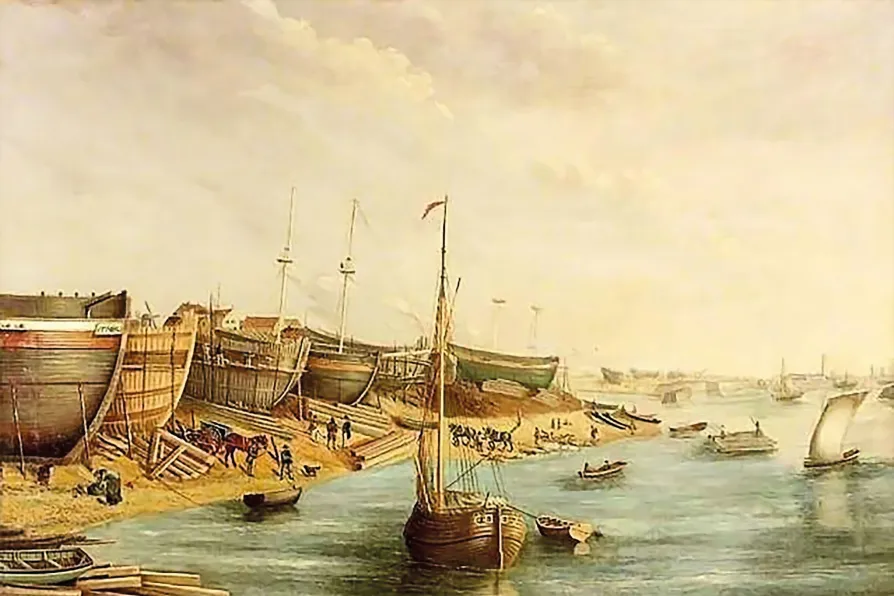Alvaro Uribe is found guilty of witness tampering and procedural fraud, reports NICK MACWILLIAM
Error message
An error occurred while searching, try again later.DR DAVID GORDON SCOTT tells the story of the North Sands Massacre, Sunderland, as part of the ongoing work of remembrance of those killed by soldiers during the 1825 Seafarers Strike and the bicentennial commemorations on Sunday August 3

 INDUSTRY: A view of William Pile’s shipyard on the North Sands, Sunderland, in the 1830s showing various ships under construction and repair
INDUSTRY: A view of William Pile’s shipyard on the North Sands, Sunderland, in the 1830s showing various ships under construction and repair
SEVEN people from Sunderland shot dead by soldiers 200 years ago are to be remembered at an event this coming Sunday August 3 2025.
The seven deaths arose during attempts to end a bitter strike back in 1825, led by local seafarers who were resisting wage cuts and reasonably demanding that they be paid for all the work that they performed for the ship owners.
The killings on North Sands beach, Sunderland, were met with anger and outrage, with many local people at the time believing those who died had been wilfully murdered.
At the time, the killings made national headlines and undoubtedly were one of the most significant events of 1825. The most obvious comparison to what happened in Sunderland in 1825 is the infamous massacre at Peterloo at St Peter’s Field in Manchester on August 16 1819. Yet knowledge and awareness of these two events today are vastly different. Though the seafarers’ union — the Seamen’s Loyal Standard Association — noted that August 3 1825 should “ever be remembered” the North Sands Massacre over time had been virtually forgotten.
The 1825 seamen’s strike
In 1825, the number of sailors working on the River Wear was estimated to be over 4,200, with nearly 600 vessels registered at the port of Sunderland. In October the previous year, an embryonic trade union, the Seamen’s Loyal Standard Association (SLSA), had been officially formed on the Tyne and Wear.
Within two months of its founding, the SLSA had over 1,200 members. Although its “articles of agreement” stressed the benevolent side of their organisation, such as providing sick pay, pensions, and compensation for death and injury in service for its members, the SLSA were also concerned about wages and working conditions.
The economic boom of 1822-4 had, by early 1825, ended abruptly, and one of the most severe financial crises in British history was brewing. Although the banking crisis did not reach its pinnacle until December 1825, throughout the year, there was economic turmoil, and employers were looking to reduce costs. This included shipping, and there was increased pressure to reduce the wages. At the same time, the living conditions of ordinary working people were also being pushed down, while prices for basic necessities were rising. There was also the menacing spectre of unemployment, and by August 1825, several hundred sailors based in Sunderland were out of work.
The North Sands Massacre
During the 1825 strike, ships were prevented from leaving port. On the day before the massacre, attempts to negotiate a settlement collapsed, so striking seamen returned to the River Wear on their small coble boats to prevent larger ships from sailing.
The shipowners attempted to break the strike. On August 3 1825, under the leadership of local magistrate John Davison and Lieutenant Phillips, 12 soldiers from the 3rd Light Dragoons themselves boarded boats to stop the strikers’ disruption. The striking seamen on the river retreated to the stony beach at North Sands, where more than 100 people, including women and children, had gathered. Davison consulted with Lieutenant Phillips before giving the troops orders to open fire.
Six people were seriously wounded, and at least seven people were killed:
Thomas Aird. Aged 42, he was a sailor who died of a gunshot wound to the back of the head. He died within an hour of injury. He left a widow and one child. His death was the focus of the first inquest. Inquest verdict: “Justifiable homicide.”
Richard Wallace. Aged 45, he was a ship captain. He was shot across the breast and died instantly. He left a widow (in dying state) and two children. Inquest verdict: “Justifiable homicide.”
John Dover. Aged 27, from Fitters Row. He left a pregnant widow and three children (although one report suggests he was unmarried and sole support for his widowed mother, Betty Dover). Inquest verdict: “Justifiable homicide.”
Ralph Hunter Creighton. Aged 22, a single man, shot dead while working as a carpenter at a nearby shipyard on North Sands, probably owned by William Pile. There was a separate second inquest for Creighton. Inquest verdict: “Accidental death.”
James Quigley. Aged 31, a labourer from Monkwearmouth. He left a widow and three children. He was hit by a stray bullet while walking home from work. There was no inquest into his death.
In addition, the names of two other people are recorded as killed in the parish records:
Thomas Wilkinson. Aged 25, from George Street. He is listed in the Holy Trinity burial records as having been “Kill (sic) 3rd Aug 1825.” There was no inquest into his death.
Mary Wilson. Aged 76 from Union Lane. She was buried on August 7 and on her burial record the words “Killed Aug 3rd” have been written in and then, for some reason, crossed out. There was no inquest into her death.
The funeral procession comprised 1,200 people. Mourners sang, wore black crepe and solemnly placed a British flag on the coffins. Within a few days, the strike was over. Criminal court cases followed in October 1825, and eight strikers were imprisoned: John Williamson, John Hall, Joseph Howe, Turner Wilson, John Fenwick, James Addy, George Hudspeth and John Taylor.
The bicentennial commemorations will take place on Sunday August 3 2025, exactly 200 years after the events. Anyone wishing to attend can join the North Sands Bicentennial Committee from 2pm at St Peter's Church. There will be a short procession from the church (starting at 2.15pm) to the site of the massacre, near the Sunderland University student union building, followed by the laying of a commemorative wreath, created by Bishopwearmouth Co-operative florists.
Speakers include the mayor of Sunderland, the national secretary of the RMT union and historians representing the National Archives, Sunderland Antiquarian Society and The Open University. Local musician Eileen Richardson will also read a poem and sing traditional Sunderland seafarers’ songs of the time. World-renowned singer Marty Longstaff will perform two songs to open and close the event.










